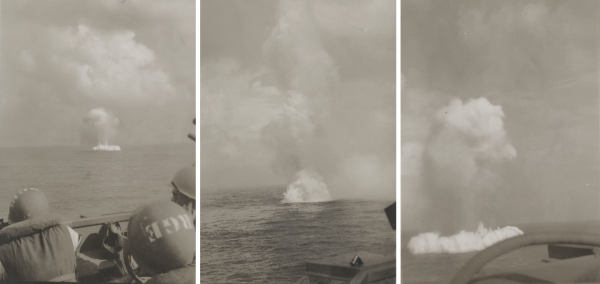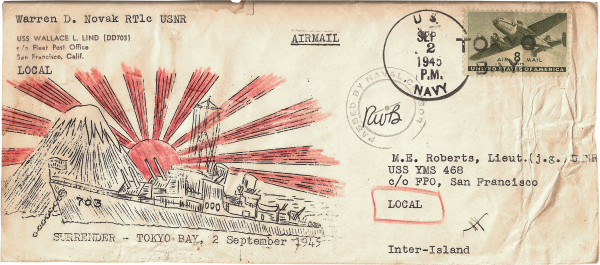Some months ago, I was contacted by a sailor who served aboard a sibling minesweeper across the American, European, and Pacific theatres of WWII. Lieutenant Marty Roberts of Raleigh, NC served aboard YMS-468 as Engineering Officer and later Deck Officer, from 1943 to 1946. Marty wrote up this biography of his naval service for his grandson and was kind enough to share it and his photographs with us.
This post is an eight-part series. Below is an index of all parts. Enjoy!
Marty Roberts of Raleigh, NC | February 28th, 2014
Navy Days – A Letter to Joe
- Part 1: In training
- Part 2: YMS-468 on the US East Coast
- Part 3: YMS-468 through Panama Canal, in prep for battle
- Part 4: YMS-468 on the US West Coast, into the Pacific Theatre
- Part 5: YMS-468 in battle, up to Japan’s surrender
- Part 6: YMS-468 in Makurazaki Typhoon
- Part 7: YMS-468 moored in Japan’s occupation
- Part 8: After the war
Part 5 of 8: YMS-468 in battle, up to Japan’s surrender
Our first operation consisted of more than 80 ships in an echelon formation that extended clear over the horizon and took all day to sweep one pass through the line of mines. Luckily for us, the Japs were meticulous in laying these mines in quite a straight line. Other ships were assigned the task of following the sweeps to destroy the mines that were cut and popped up to the surface from their anchored position just below the surface. Some days we were assigned that job and it really was fun to explode the mines with rifle fire as seen in the pictures below.
Around this time we began to hear some vague rumors about the testing of a new unbelievably powerful bomb. But no other news concerning it.
We had been so long at sea that few of the men bothered to wear their helmets but when the first mine we detonated resulted in sprinkling the deck with shrapnel they soon corrected that mistake! It also was funny to watch them try to pick up pieces of shrapnel for souvenirs only to discover they were still red hot from the explosion. They’d stand around the piece to see who would dare grab it first. Some mines didn’t explode but just spewed out black smoke and we would have to shoot holes in them until they sank. Obviously this task had to be completed before dark so as to be sure no mines were left floating around as the whole formation swung into position for the next day’s pass across the mine line.
On one occasion we were assigned the job of dropping an anchor buoy at the last cut through the mine line so the first sweep in the morning would know where to start. I had the bridge at the time and the skipper and exec were back aft supervising launching the buoy. Somehow one of the seamen let his arm get caught in the buoy cable as it uncoiled after the launch and he was pulled overboard. Fortunately, he got free of the wire and we were able to rescue him. Another ship had the task of plotting exactly where the buoy was dropped and they had a fit telling us we were in unswept waters but I was sure I maneuvered around to avoid this and we did not get into any trouble.
After completing this operation we returned to Buckner Bay, Okinawa and just as we entered I began to hear a steady, loud banging noise and thought we had developed a bad main thrust bearing. Investigation proved this not to be the case so after we anchored I decided to have a look at the propeller shafts under the stern of the ship and dove down to discover one of our propellers had picked up a swab [a yarn mop] and the broken wooden handle was beating on the bottom of the ship with every revolution of the shaft! A sharp knife cut through the strings of the swab and all was well again and the swim felt good.
Although the Island was pretty well secured by this time there was still the occasional Jap air raid which required us to stay on watch for possible air attacks. To avoid confusion the Air Force, who were now operating from an airfield nearby, agreed to defend the airspace over Buckner Bay and requested the Navy not to open fire in the event of an attack; they would take care of it. One night a plane was sighted and we all went to GQ but were told not to open fire. This seemed OK because the plane had its running lights on and everyone assumed it was friendly and intending to land. It circled the harbor low and dropped a torpedo which hit one of our battleships! All the ships in the harbor evidently said, “to hell with the Air Force” and opened fire on the Jap who by this time accelerated out of the area and disappeared. I never heard the repercussions that must have taken place over this incident.
Shortly after this we were warned of a typhoon approaching and were ordered to go to sea and take cover in one of the small fjords around the northern tip of Okinawa. While safely tucked away in this anchorage one evening watching an old movie we received a message that the Japs had surrendered and everyone breathed a big sigh of relief and as I recall we quietly watched the rest of the movie. Then it was time to break out the “medicine” from under my bunk and celebrate! This was on the 15th of August, 1945.
The war may have been over but the minesweeping operation still had to go on and we continued our efforts to rid the waters of these threats to shipping. On September 2nd, the formal surrender took place in Tokyo harbor, the details of which can be found at the Naval History and Heritage Command website and this contains a reference link to a list of all the Allied ships present in Tokyo Bay at that time. There were even some YMS’s there. (They swept the harbor before the rest of the ships came in!) I think the exact Terms of Surrender quoted in the article are very interesting to read.
One of my fraternity brothers from college days was an Electronics Technician, 1st Class (ET1c) for a squadron of destroyers present on the occasion and he sent me a letter dated September 2nd, 1945 in an envelope designed especially for this event depicting his ship the DD-703 (USS Wallace L. Lind) which is included in the list of ships referred to above. Here is a copy of the envelope.
This post is an eight-part series. Below is an index of all parts. Enjoy!
Marty Roberts of Raleigh, NC | February 28th, 2014
Navy Days – A Letter to Joe
- Part 1: In training
- Part 2: YMS-468 on the US East Coast
- Part 3: YMS-468 through Panama Canal, in prep for battle
- Part 4: YMS-468 on the US West Coast, into the Pacific Theatre
- Part 5: YMS-468 in battle, up to Japan’s surrender
- Part 6: YMS-468 in Makurazaki Typhoon
- Part 7: YMS-468 moored in Japan’s occupation
- Part 8: After the war

